You are in the
LISBON FUNICULARS & ELEVATORS
page
|
Links to rest of site:
LISBON TRANSPORT
Air Museum
Azambuja Rail Line
Carris & Ticketing
Cascais Rail Line
Coach Museum & Other Museums
Eating & Drinking
Fertagus Rail Line
Lisbon Aviation
Lisbon Bridges
Lisbon Buses
Lisbon Cablecar
Lisbon Coach Trips
Lisbon Day Trip
Lisbon Ferries
Lisbon Funiculars & Lifts
Lisbon Metro
Lisbon Railways
Lisbon Railway Trips
Lisbon Ships
Lisbon Suburban
Buses
Lisbon Taxis
Lisbon Trams
Maritime Museum
Metro do Sul do Tejo
Oeiras Monorail
Sintra Rail Line
Sintra Transport
OPORTO TRANSPORT
Oporto Airport
Oporto's Bridges
Oporto Buses
Oporto (Gaia) Cable Car
Oporto Coaches
Oporto Excursions: Régua, Lamego
Oporto Funicular
Oporto Metro
Oporto Railways
Oporto Railway Trip to Coimbra
Oporto River Vessels
Oporto Tram Museum
Oporto Trams & Trolleybuses
Oporto Tram Routes Now
Oporto Transport Museum
Eating & Drinking in Oporto
ANGLO-PORTUGUESE CULTURE
Cesário Verde
Manchester/Portugal
GERMANY
Stuttgart & district
Hamburg & district
Mainz & district
Munich & district
SPAIN
Valladolid & the Cities of Castile & León
LOCAL HISTORY
Sale, Cheshire
Altrincham, Cheshire
Altrincham F.C.
|

Lisbon Funiculars, Cable Tramways, Elevators, Lifts and Similar Structures
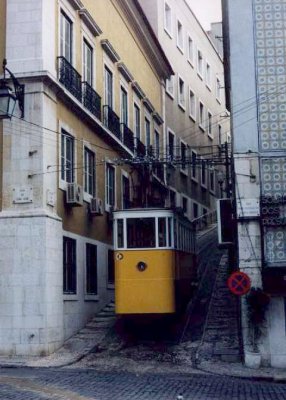 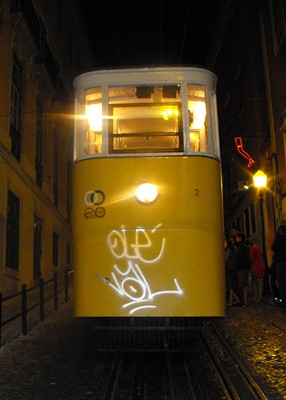
Left: The Lavra funicular. Right: The Glória funicular at night (2012).

Although separate tickets used to be issued for upward or downward trips on the Elevadores, the fare was the same in each direction, as the above tickets from 1975/76 illustrate. Prior to the introduction of the euro, the Portuguese currency was the escudo, whose symbol was the $. The tickets shown cost 50 centavos each, or half an escudo, which was fully written as 0$50, so the fare was NOT 50 US dollars each way!
 June 2019 June 2019
Copyright: ©
|
Street Funiculars
Lisbon has three working street funiculars and one street elevator which allow its citizens and visitors to move to and from its hilly districts more easily. All are operated by Carris, the Lisbon city transport undertaking. A new elevator also opened in 2000 at Almada, on the opposite bank of the Tagus (see below). Viva Viagem "ML" tickets (i.e. ones bought at Metro stations, for example) are valid on the funiculars.
The Lavra Funicular
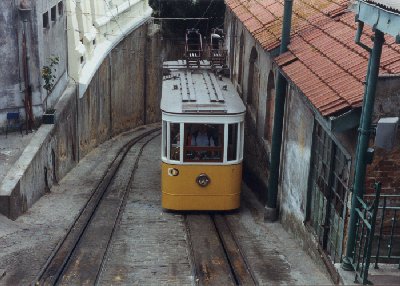
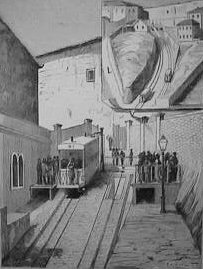
Left to right: the Lavra funicular at the Torel summit, July 1998; a late nineteenth-century engraving of the Lavra funicular.
The Lavra funicular was the first street funicular in the world. It opened on 19 April 1884 and carried 3,000 people, free of charge, on that day alone. Originally water-powered, it was converted to electricity in 1915. It runs from the eastern side of the Avenida da Liberdade at a 25% gradient for 180 metres to the Torel district. Originally it operated on a water counter-weight system, but was subsequently electrified. Hours of operation (2010) are 0700-2100, every day except Sunday, when the opening time is 0900. To reach the bottom of the funicular, turn right off the Avenida da Liberdade, whilst heading north, into the Largo da Anunciada. This turning is slightly further up the Avenida than the main tourist office in Restauradores, on the opposite side of the road. The Lavra funicular is to be found about 100 yards along the Largo da Anunciada. The route was closed from 21 June to 5 July, 2006 following an accident but service was restored soon afterwards.
The vehicles are parked overnight towards the top end of the route and their exposed position has sadly left them prey to graffiti "artists" who have ruined their appearance.
The Glória Funicular
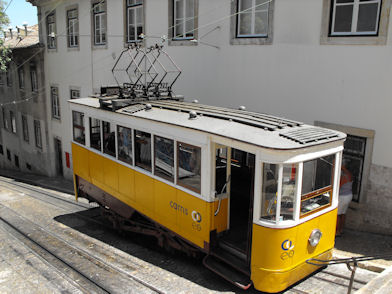
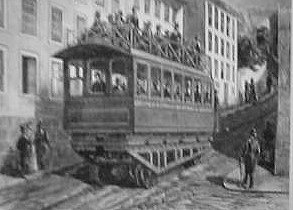

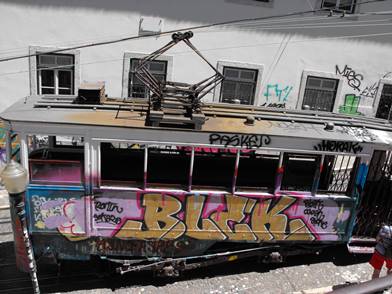
L. to R.: The Glória funicular: car 2 at the summit; the double-deck Glória funicular in its early days; the Glória, out of action because of works on the Rossio tunnel, June 2007; the deplorable state of the funicular in 2019, totally covered by graffiti.
The Glória funicular opened on 24 October, 1885, on the west side of the Avenida da Liberdade, connecting Restauradores with the Bairro Alto. Excellent views of the city and castle are to be had from the gardens which lie immediately to the right of the top of the route. Just across the road, slightly to the right, at Rua de S. Pedro de Alcântara, nos.39-49, lise the Instituto do Vinho do Porto, where a vast range of port-wines may be tasted and purchased in the sumptuous surroundings of the Palácio Ludovice (1749). The Glória is the busiest funicular in Lisbon and also the most accessible for tourists as it lies next door to the main tourist information office in the Palácio Foz. It is 265 metres long and has an average gradient of 18%.
Operating hours are approx. 0700-0055 every day. Sadly, the cars are now defaced by graffiti. In 2006-08, the Glória funicular was out of action whilst remedial works took place on the Rossio railway tunnel which runs beneath the funicular track. The closure started from 17 April 2006, supposedly for six months but it was still closed 18 months later. However, it is now fully operative again.
As with the Lavra and Bica funiculars, both Glória vehicles are badly affected by graffiti on their exteriors.
The Bica Funicular
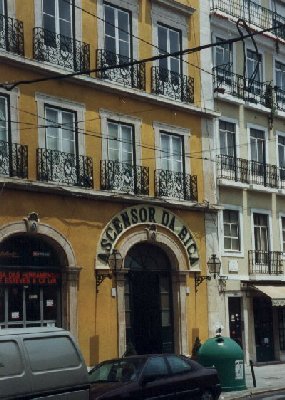
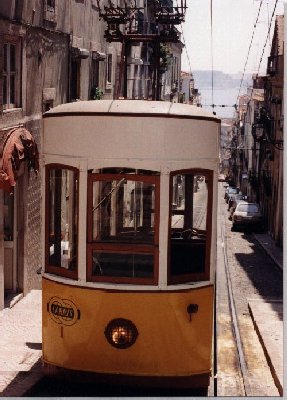
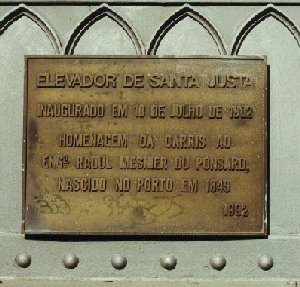
L to R: The entrance to the Bica funicular in Rua S. Paulo and one of the two passenger cars; the commemorative plaque on the base of the Santa Justa elevator.
The Bica funicular opened on 28 June, 1892 and is the only stepped street funicular in the city. It climbs the Rua da Bica for 245 metres from the Rua S. Paulo,
near Santos, to the Calhariz district. Its average gradient is 20% but is much steeper at the lower end (S.Paulo). From the street, the funicular is concealed by
a building but this is clearly lettered 'Ascensor da Bica'. Originally water-powered, steam-power was introduced in 1896, followed by electricity from 1914.
The service operates the same hours as the Lavra facility (see above). Tram #28 runs past the top end and tram #25 passes the bottom end
of the Bica route. The Bica funicular was closed from 8-22 May 2000 for refurbishment works and again in June/July 2012 but has remained fully operational between such overhauls.
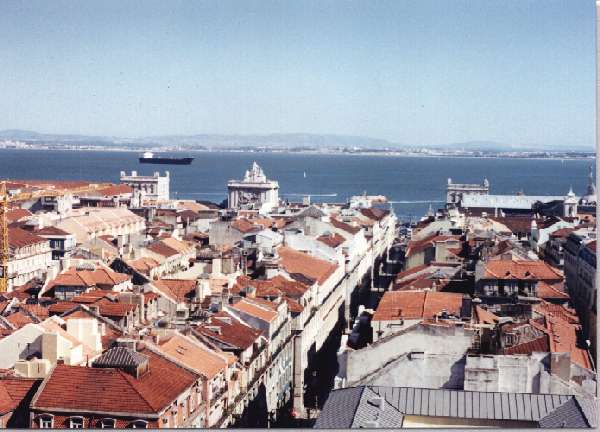
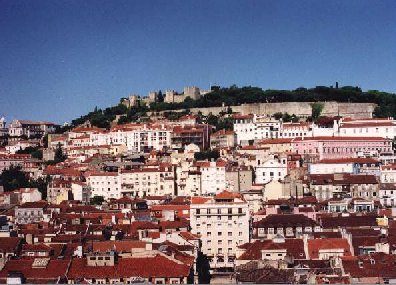
Views from the top of the Santa Justa elevator, (left) towards the Tagus and
right, towards the Castelo de São Jorge. Click to enlarge.
Elevador de Santa Justa/ Santa Justa Street Elevator
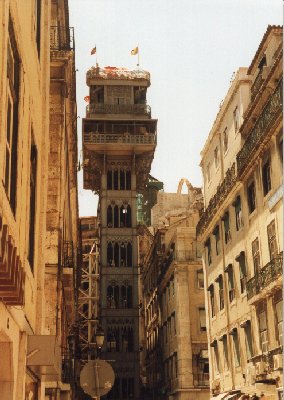 The Santa Justa Elevator opened in 1902 and rises vertically some 45 metres from the Rua de Santa Justa in the Baixa area of central Lisbon to the Chiado district. The structure was designed by Raoul Mesnier du Ponsard, from Oporto. The structure houses two staffed lifts which normally allow direct access to the Carmo square and its monastery ruins, which are now an archaeological museum.
The Santa Justa Elevator opened in 1902 and rises vertically some 45 metres from the Rua de Santa Justa in the Baixa area of central Lisbon to the Chiado district. The structure was designed by Raoul Mesnier du Ponsard, from Oporto. The structure houses two staffed lifts which normally allow direct access to the Carmo square and its monastery ruins, which are now an archaeological museum.
From 1999 access at the top was limited to the elevator viewing deck only, due to building works. This meant that if it was quiet, you were at the mercy of the lift operator regarding the timing of your descent. But by January 2006, the 25 metre walkway to the Chiado was open once again. For decades the prices of the ticket to ascend the lift was minimal; by 2019 it had risen to more than five euros for a return ticket yet it still attracts large queues in summer.
However, an alternative, less interesting but totally free route from the Baixa to the Chiado district is to use the escalators in the nearby Baixa-Chiado Metro station. Enter the station off the Rua Aurea, go down the double-flight escaltor to the station's turnstiles, walk straight on past the turnstiles then ascend the four-flight escalators to emerge in the Chiado. No ticket is needed.
The vertical column of the Sta Justa elevator measures some 7m x 7.5m and the 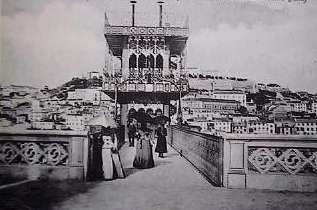 lift was originally powered by a steam engine mounted on its summit. Since 6 November, 1907 it has been electrically powered. On exiting the lift at the top, the area, below, to the left of the walkway was largely destroyed by a major fire in 1988 but has now been rebuilt. Alternatively passengers may linger in the viewing area which looks over Rossio to the north east and the Baixa district to the south. To the east are fine views across to the Castle and Graça. There is also a café at the summit but a small restaurant on the walkway is now closed. The walkway runs alongside the ruins of the Carmo monastery which has been left unrepaired since the catastrophic earthquake of 1 November, 1755. Carris trams formerly ran to the end of the walkway and the track stub remained intact (at least till 2007).
lift was originally powered by a steam engine mounted on its summit. Since 6 November, 1907 it has been electrically powered. On exiting the lift at the top, the area, below, to the left of the walkway was largely destroyed by a major fire in 1988 but has now been rebuilt. Alternatively passengers may linger in the viewing area which looks over Rossio to the north east and the Baixa district to the south. To the east are fine views across to the Castle and Graça. There is also a café at the summit but a small restaurant on the walkway is now closed. The walkway runs alongside the ruins of the Carmo monastery which has been left unrepaired since the catastrophic earthquake of 1 November, 1755. Carris trams formerly ran to the end of the walkway and the track stub remained intact (at least till 2007).
Nowadays there is no tram service immediately adjacent, as the #24 service from Carmo to Alfândega was withdrawn in the 1990s. However, part of this route was reopened in 2018 but this no longer runs from Carmo. Instead it operates five minutes' walk away from Pç. Camões (see the Lisbon Trams page).
All of the above services are operated by Carris, which also operates Lisbon's bus and tram services.
Former Street Elevators
The Elevador do Chiado linked the Rua do Carmo and the Rua do Crucifixo. It was a hydraulic lift which functioned from 15 February, 1892 until 1912.
The Elevador da Biblioteca Pública connected the Lisbon Public Library to the Calçada de S. Francisco. It operated between
12 January 1897 and 1915.
Former Cable Tramways
Camões to Estrela. This 1.7km service ran from 14 August,
1890 to 3 July, 1913 on a 900mm gauge. The route is now operated by electric
trams, which have run since 1914.
Rua da Palma to Largo da Graça. Also a 900mm gauge operation, it
ran for 730 metres, climbing 75 metres. Services began on 27 February 1893
and ceased in 1909.
Largo de S. Domingos to S. Sebastião. This route served the then
Lisbon zoo. Although it only opened in January 1899, it was already defunct
by 1903.
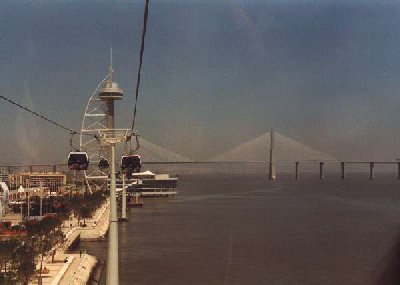
Torre Vasco da Gama
The Torre Vasco da Gama (Vasco da Gama Tower), seen left at the end of the cablecar route, is a 145 metres tower constructed by the Lisbon bank of the River Tagus for the Expo 98 events. The tower is sited at the north end of the Expo site, now renamed the Parque das Nações and offers excellent views of the Vasco da Gama bridge to the north. Also visible from the tower's viewing deck (104m.) is the approach to the Oriente railway station and, further off, the airport at Portela de Sacavém. The viewing area is accessed by a glass-fronted Thyssen lift and whilst there are no facilities at the top, other than a 360 degree viewing area, there is a café at the foot of the lift. The tower is named after the Portuguese navigator, Vasco da Gama, who sailed from Lisbon to round the Cape of Good Hope in 1498.
Boca do Vento
A new 'elevador' opened on 1 July, 2000 at Almada, across the river from Lisbon, not far upriver from the striking Cristo Rei (Christ, the King) statue, which itself can be ascended by lift. This is the Elevador Panorâmico da Boca do Vento, which was constructed at a cost of £1.5M to link the riverside area with the historic town centre, some 50 metres above, chiefly for the benefit of tourists.
An alternative route to the Cristo Rei itself is to take the ferry to Cacilhas and catch the 101 bus which terminates there. Or, you can get the MST tram from Cacilhas to Almada and go up the road at the side of the excellent Café Tropical, the Avenida do Cristo Rei. This is a ten-minute uphill walk but not too steep. Tickets to ascend to the feet of the statute are available from a vending machine inside the statue's base and the view make this well worth the modest price. As well as close up views of the Ponte 25 de Abril, the whole north bank from Cascais to the Ponte Vasco da Gama can be seen, as well as the nearby towns of Cacilhas and Almada, whose local football team, Atlético, must have one of the best sited grounds in Europe, at the foot of the Cristo Rei!
Padrão dos Descobrimentos
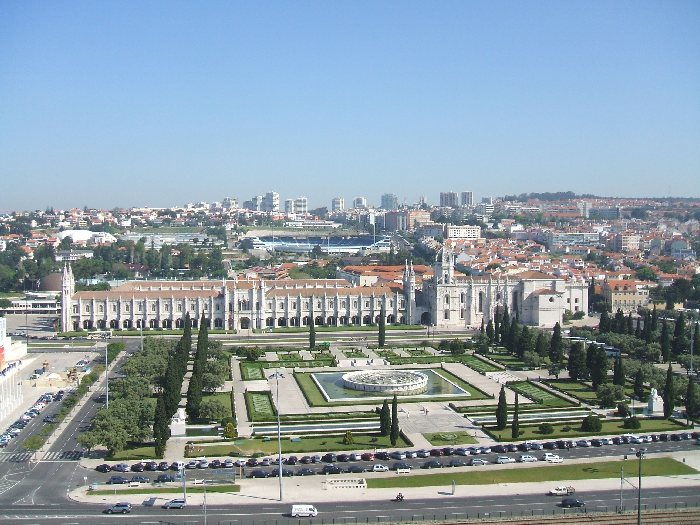
The striking Padrão dos Descobrimentos, on the waterfront at Belém, is a monument to the Portuguese Discoveries. It incorporates a lift from which there are excellent views along the River Tagus as well as across the Belém area towards the Jerónimos monastery (above). The monument was originally erected in 1940 for the World Exhibition but the existing structure was not completed till 1960, the 500th anniversary of the death of Prince Henry the Navigator. The lift also affords an excellent view of the marble Rosa dos Ventos (compass) pavement decoration adjacent to the monument.
Arco da Rua Augusta
In summer 2012 the iconic arch at the river end of the Rua Augusta was opened to the public. Using a lift and spiral staircase, magnificent views across the Pç do Comércio can be had, including an elevated perspective on the city's tram services. Admission in 2019 was three Euros.
Other Elevators
Elevador do Castelo
Given the busy nature of the 12 and 28 trams and the 737 bus to Lisbon's Castelo de S. Jorge, an easy and totally free way to get to the castle on foot is to use the inconspicuous two-stage Elevador do Castelo.
This is a two-stage lift. The lower element was built (2012) inside a hollowed-out building at 176 Rua dos Fanqueiros, a road which runs from the north-east corner of the Praça do Comércio to the Praça Figueira. It is far from obvious unless you look up and spot the large sign at roof level proclaiming "Elevador do Castelo". You can just walk into the premises and get in the lift without any formality at all. At the top, you emerge into a street where there is nothing obvious to suggest the way to the castle but, if you take a few paces to the left and then cross the road you will see the Pingo Doce supermarket. At the right-hand side, an inconspicuous sign proclaims "Elevador do Castelo", which is the second stage of the ascent. Enter the premises door and the two lifts are straight ahead of you.
At the top of this second-stage lift, there is a road sign directing you to the right, to the Castelo, which is just a few minutes' walk away.
This second stage of the lift was already in existence in 2011, via the Rua da Madalena, before the second stage came into use a year later.
Ponte 25 de Abril: PIlar 7
A recent addition to the elevators of Lisbon is the Pilar 7 which allows visitors to ascend part of the Ponte 25 de Abril which crosses the Tagus. As the Pilar 7 website explains, "Located in Alcântara (Avenida da Índia), this interactive centre allows all visitors to have an unique experience of the bridge, considered one of the prettiest in the world, via a tour that takes in the exterior areas of this key pillar and the sensory experience of visiting its interior.
It is a trip through the history of its construction and ends with an elevator ride up to a panoramic viewing point that provides an unrivalled view of the city and the river.
Making use of modern multimedia devices, your visit ends with an immersive virtualreality experience of parts of the bridge that are inaccessible and a call at the PhotoBooth so you can record this unforgettable moment".
Admission for adults is €6 (2019) and the venue can be reached via nearby tram 15 or buses 714, 727, 732, 751, and train to Alcântara-Mar on the Cascais line.
Copyright: ©
Contact: the following is not a link; please transcribe the address into your email 



 June 2019
June 2019
















